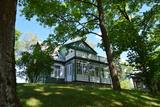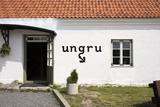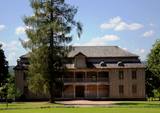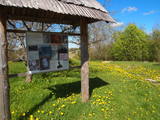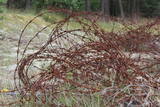| Нo | Название | Описание |
|---|---|---|
|
In Aizkraukle, drive down Enerģētiķu Street to the Selonian side (there will be small “pockets” at the side of the road) to see one of the best views of the Daugava River valley, reminding us of what this fateful river was like before the power plant was built. You will see that the river has eroded the steep cliffs on the right bank. The further part of the valley is part of the Daugava Nature Park.
|
||
|
Мемориальный музей А. Баранаускаса и А. Венуолиса-Жукаускаса был основан в 1927 г. Сотрудники музея собирают, хранят и популяризируют музейные ценности, отображающие развитие культуры, литературы, истории, аграрной культуры, техники Аникшчяйского края. Для прогулок круглогодично открыт мемориальный парк Горки писателей. |
||
|
Puises „centrā” uz vienstāvu koka mājiņas jumta izveidota skatu platforma. No tās paveras laba ainava uz ciemu, ostu un piekrastes kadiķu laukiem. |
||
|
~ 3 – 5 km gara taka, kas ved pa veco ceļu gar Tēramā upes (Tõramaa jõgi) kreiso krastu. Takas malās izvietoti interaktīvi elementi bērniem, kas palīdz labāk uztvert dabā notiekošo. Taku ieskauj mitrie meži un palieņu pļavas, kas palu laikā atrodas zem ūdens. Tēramā (Tõramaa) ciemā apkārtnē atrastas cilvēka darbības pēdas jau no akmens laikmeta. |
||
|
Находится недалеко от автодороги А 9, к западу от дома Батаров, где 22 марта 1919 года состоялся бой между бригадой генерала Яниса Балодиса и большевиками. Открыт в 1936 году. |
||
|
Pankūku kafejnīca. Dažādi oriģināli pildījumi. Kafejnīca piedāvā svaigi grauzdētu kafiju, kafijas un alkoholiskos dzērienus, kā arī uzkodas. Atvērta tipa virtuve. |
||
|
Учебные мастерские и домашние кафе распространены по всей Эстонии, но преимущественно они встречаются в регионе Пейпсимаа. Во время занятия в мастерской участники с помощью руководителя готовят 3-4 блюда, которые потом все вместе дегустируют. Акцент делается на продуктах, встречающихся в окрестностях Пейпсимаа, и полюбившихся рецептах. Учебные мастерские в основном проводятся под открытым небом, а еду готовят на кострах, используя котлы и самоваром. Зимой мастерские проводятся даже на льду озера Пейпус. |
||
|
Ungru is a seaside hotel in the north of Hiiumaa. There is a high-class restaurant on the ground floor. The second floor has 4 rooms with all amenities. Dauble Deluxe beds with sea views. |
||
|
Taka ved gar Vaidavas krastu, kur iespējams veldzēties dabas skaistumā, kāds vērojams tikai šeit. Starp Apes vidusskolu un kapsētu Vaidavas upes kreisajā krastā ir izveidojušies 8 - 10 m augsti, līdz pat 100 m gari smilšakmens atsegumi - Raganu klintis. To lejasdaļā upes straume izskalojusi nelielas nišas. Pie klintīm pāri upei izveidots gajēju tiltiņš uz otru krastu, no kura klintis paveras visā savā krāšņumā. Te ir teikām un nostāstiem apvīti avoti un alas. Avots ar skaidru ūdeni iztek no vietas, kur Vaidavas upes smilšu klints krasts ir augsts un stāvs. Senāk vietējie ticējuši, ka tas ir veselības avots, jo daudzi to lietojuši dažādām acu slimībām.Dīvainos dabas objektus – Vilkaču priedi un Dvīņu priedes, Raganu slotu, “raganu apļus”, “raganu kaulus” u.c. te var apskatīt un vides gida vadībā mēģināt izprast to veidošanos
|
||
|
Находится на обочине дороги Друвиена – Лиэзерс. В историческом здании школы в 1964 г. создан музей. Имя школы связано с латышским писателем Янисом Поруком (1871 - 1911), в часть которого создана памятная комната. На втором этаже можно побывать в классе, посидеть на старинных школьных скамьях и ощутить себя учеником прошлого. Интересные экспонаты – сундуки для хлеба, - такие же, как во времена героев рассказов Порука – Цибиня и Буньга. |
||
|
Место, где стояла усадьба Куртувенай, окружено старым парком геометрически-пейзажной планировки. Во второй половине XIX в. парк отличался ландшафтным стилем (т. е. повторял естественный природный ландшафт) с некоторыми элементами геометрической структуры. Территория парка составляет 4,2 га. Здесь до сих пор произрастают старые липы, клены, ясени, дубы, другие декоративные деревья и кустарники — в целом более 20 пород древесных растений |
||
|
Бывшая узкоколейка – сохранилось место станции, багажный склад, жилое
здание начальника станции, а также само «полотно» маленького паровозика.
|
||
|
Latvijas un Igaunijas Neatkarības karā nenovērtējami nozīmīgas bija tieši Cēsu kaujas 1919.gada jūnijā.Atpūtas vieta-kempings "Amatas upe" ir lieciniece tieši šo un vairāku citu kara notikumu norisei - par to liecina vēsturiskie avoti muzeju arhīvos, kā arī mūsdienās redzamās aprises dabā. Par to, kur un kā sākās varoņstāsts, kas noslēdzās ar abu kaimiņtautu: igauņu un latviešu brīvību, ir iespējams uzzināt arī dažādu veidu programmās - stāstījumā par Cēsu kauju noslēpumiem un dažādu veidu pārgājienos vai izbraucienos pa galvenajām Cēsu kauju vietām, vai arī Cēsu kauju aizraujošā "izspēlēšanā". Atpūtas daļā - apmeklētājiem ir iespēja nobaudīt spēcinošu "kara zupu". Ekskursijas pa Cēsu kauju vietām-dažāda ilguma, izstrādāsim tieši jums piemērotu variantu! |
||
|
The Sietiņiezis cliff is on the right bank of the Gauja River between Valmiera and Jāņmuiža (follow signs along the road). There is a circular nature trail here. Sietiņiezis is one of the largest white sandstone cliffs in Latvia, up to 15 m high and around 500 metres long. There is an interesting diversity in form here, with small caves and niches, erosion-based ravines, as well as sandstone formations which are reminiscent of poles. The word "sietiņš" refers to "sieve," and the cliff is so called because bees have drilled holes into it for time eternal. From the southern part of Sietiņiezis, you can get a good look at the ancient Gauja River valley, and all around it are lovely pine forests. There is a place on the banks of the Gauja which is meant for campfires and meals. |
||
|
Находится в центре старого города - на перекрестке Латгальской и Церковной улиц. Церковь строили в период с 1843 – 1845 годы в стиле русского классицизма. Недавно восстановлена роспись потолков и стен. В башне храма располагается колокол весом 1667 кг. |
||
|
Durch das höchste Dünen-Massiv Estlands und den Moor führt der Lehr-Wanderweg. Blick vom Aussichtsturm bis auf die Insel Kihnu. |
||
|
The town of Talsi is known as the “town of the nine hillocks,” and it is worth touring the location on foot. You’ll find the best views from the Talsi castle hill (views of Lake Talsi and Ķēniņkalns Hill), Sauleskalns (Lake Talsi, the castle hill, Ķēniņkalns Hill), and the hiking trails of Ķēniņkalns (Lake Talsi, the castle hill, the historical town centre).
|
||
|
В хозяйстве создана современнейшая в Балтии кроличья ферма. Кролики живут в кроличьих баньках, а снаружи – в смотровых вольерах. Дети могут познакомиться с 24 породами кроликов и осмотреть окрестности со смотровой вышки. По предварительной договоренности – покупка свежей крольчатины, колбас, копченостей и паштета. Новинка – венгерские дикие свини Мангалица. |
||
|
Продолжительность маршрута до 12 дней с самостоятельным транспортом. Общее расстояние около 1 500 км. |
||
|
Ракетная база противовоздушной обороны располагалась на обширной территории на юге от Павилосты. Заброшенная и деградированная природная территория, где размещены предупреждающие знаки «Опасно для жизни».
|
||

